Scroll to:
Investigation of thermodynamic parameters of the air environment in subway lines with single-track and double-track tunnels
https://doi.org/10.17073/2500-0632-2024-02-223
Abstract
The study of thermodynamic parameters in the air environment of subway lines is of particular relevance due to the substantial differences in air temperatures between Russian cities and those abroad. These temperature variations influence the formation of aerothermodynamic characteristics, which must be considered when selecting methods to ensure compliance with standard climatic parameters in subway systems. The objective of the study presented in this article was to identify, based on experimental data, the patterns governing aerothermodynamic processes, with the aim of providing recommendations for the standardization of air environment parameters in subway tunnels (both single- and double-track) located at different depths. The primary tasks of the research involved identifying the factors influencing the distribution and variation of temperature and humidity, conducting instrumental measurements of temperature and humidity distribution along the length of the transit tunnel sections under investigation, both in the absence of trains and during varying intensities of train movement. Proposals were then developed to apply the identified patterns in maintaining standard air parameters. The article posits that the selection of technical solutions for improving subway ventilation systems should be based on the unique features of aerothermodynamic processes, which depend on the structural characteristics of the transit tunnels and their depth. Experimental studies revealed the patterns governing the formation of ventilation and thermal regimes in single-track and double-track tunnels, as well as at junction sections, and provided recommendations for optimizing ventilation and thermal regimes to ensure compliance with climatic standards. Specifically, the study found that in deep single-track tunnels, the thermal regime is influenced by the presence of circulation loops between adjacent stations, created by the piston effect and the heat emissions from moving trains. Circulation loops in shallow single-track tunnels, by contrast, are characterized by strong aerodynamic connections with the surface, as surface air enters the stations and tunnels via pedestrian walkways and inclined passages. In double-track underground structures, in the absence of train movement, the variation in air temperature along the length of the transit tunnel is determined by the amount of heat accumulated in the surrounding ground during periods of train operation. When trains are in motion, the heat emitted by trains moving in opposite directions is evenly distributed along the tunnel, due to the near absence of a piston effect, resulting in a stable air temperature throughout the tunnel. However, the sections adjacent to stations experience localized increases in air temperature due to the maximum heat generated during braking and train stops, with tunnel air temperatures in these sections rising by 2–3 °C compared to those in the transit sections. In sections where both single-track and double-track tunnels are present, a potential rise in air temperature at the station adjacent to single-track tunnels is associated with the formation of circulation loops between the junction of different tunnel types and the station itself. Recommendations for normalizing the aerothermodynamic regime in the various tunnel types studied include provisions for mitigating potential summer air temperature increases above the standard levels by either increasing air flow or cooling the air in cross passages adjacent to stations. Methods for increasing air temperature may include organizational, aerodynamic, and heat engineering techniques.
Keywords
For citations:
Gendler S.G., Kryukova M.S., Alferova E.L. Investigation of thermodynamic parameters of the air environment in subway lines with single-track and double-track tunnels. Mining Science and Technology (Russia). 2024;9(3):250-262. https://doi.org/10.17073/2500-0632-2024-02-223
Investigation of thermodynamic parameters of the air environment in subway lines with single-track and double-track tunnels
Introduction
Currently, subways operate in seven major cities across Russia. Each of these subway systems has its own specific characteristics in terms of structural design, technological approaches to construction and operation, and engineering support for their functioning, including ventilation systems (Table 1).
Table 1
Characteristics of Subways in Russia [compiled by the authors]
No | City | Number of stations | Subway line composition | Systems for ensuring normative air parameters | ||||
Single-track tunnel lines | Double-track tunnel lines | Ventilation | Heating (cooling) | |||||
Length, km | Depth, m | Length, km | Depth, m | |||||
1 | Moscow | 306 | ~1010 | ~60 | ~11.57 | ~17-46 | Yes | No(Yes) |
2 | St. Petersburg | 72 | ~114 | ~70 | ~10.94 | ~10-68 | Yes | No(Yes) |
3 | Nizhny Novgorod | 16 | ~22 | ~10 | – | – | Yes | Yes (Yes) |
4 | Kazan | 11 | ~16.9 | ~10 | – | – | Yes | No (no) |
5 | Samara | 10 | ~11.6 | ~20 | – | – | Yes | Yes (Yes) |
6 | Yekaterinburg | 9 | ~13.8 | 20 | – | – | Yes | Yes (Yes) |
7 | Novosibirsk | 13 | ~15.9 | 10 | – | – | Yes | Yes (Yes) |
As shown in Table 1, the vast majority of subway lines consist of both deep and shallow single-track tunnels. However, in recent years, the construction of double-track tunnels has begun in the Moscow and St. Petersburg subway systems, facilitated by the development of modern construction geotechnologies utilizing mechanized tunnel shields (MTSs) [1]. The use of MTSs has made it possible to construct double-track tunnels even under the challenging engineering and geological conditions of St. Petersburg [2].
The prospects for using double-track tunnels have been demonstrated by many years of successful operation in numerous global megacities. According to publications [3], even in hot climates, the ventilation design solutions for double-track tunnels provide more comfortable air thermodynamic parameters during operation compared to their single-track counterparts.
In Russia, double-track tunnels have been successfully operated in Moscow and St. Petersburg. There are future plans to implement double-track sections in Novosibirsk and Yekaterinburg.
Research data [4, 5] indicate that the primary factors influencing the aerothermodynamic characteristics of the air environment in tunnels include: external meteorological conditions (Table 2); the geometric parameters of the tunnel alignment, which affect the energy consumption for train movement; train operation parameters, such as speed and headway (i.e., the number of train pairs per hour); the tunnel depth relative to the surface; the type of transit tunnel (single- or double-track); ventilation schemes; and the presence of additional infrastructure between stations, such as cross-passages between single-track tunnels, ventilation structures for air supply, and other auxiliary facilities.
Table 2
Climatic conditions in Russian cities with operating subway systems [compiled by the authors]
No | City | Air temperatures | |
Average annual temperature, °C | Average winter / summer / January / July temperature, °C | ||
1 | Moscow | 7.00 | −7.5 / 20.3 / −5.5 / 20.5 |
2 | St. Petersburg | 6.75 | −6.75 / 19.17 / −4.5 / 19.5 |
3 | Nizhny Novgorod | 5.88 | −11.75 / 19.67 / −8.5 / 20 |
4 | Kazan | 5.25 | −15.5 / 20 / −10 / 20.5 |
5 | Samara | 7.08 | −13.25 / 7.08 / −9 / 22 |
6 | Yekaterinburg | 4.08 | −18.75 / 18,5 / −10.5 / 20 |
7 | Novosibirsk | 2.67 | −29.5 / 17.67 / −13.5 / 19 |
8 | Madrid | 17.42 | 18.25 / 28 / 7 / 30.5 |
9 | Rome | 18.29 | 10.17 / 27.83 / 7.5 / 29 |
10 | London | 13.29 | 13.25 / 20.16 / 6.5 / 21.5 |
11 | Turin | 13.71 | 10.25 / 22.67 / 5 / 24 |
12 | Beijing | 13.46 | −4.25 / 26.33 / −2 / 27.5 |
Table 2 positions 8–12 illustrate the differences between air temperatures in Russian cities where subway systems are located and cities abroad, where this mode of transport has seen significant development.
The harsh climate of Russia significantly affects the aerothermodynamic characteristics of the atmospheric air, which must be considered when developing measures to maintain optimal climate conditions [6].
The objective of this study is to identify, based on experimental data, the patterns of aerothermodynamic processes in subway tunnels (both single-track and double-track) located at various depths, with the goal of providing recommendations for standardizing air environment parameters.
The research methodology employed was based on experimental studies described in [7]. The mathematical models used to predict thermodynamic air parameters in underground transport systems allow for reliable verification of experimental results [8].
Experimental studies were conducted in various tunnel structures, including single-track and double-track tunnels at different depths in the St. Petersburg subway, as well as in shallow single-track tunnels in the Novosibirsk subway.
The main tasks addressed during the research include the following:
- Instrumental measurements of temperature (and humidity) distribution along the studied sections of transit tunnels, both in the absence of trains and during their movement at various intensities (measured by the number of train pairs per hour, pairs/h);
- Identification of the main factors influencing the observed temperature (and humidity) distributions;
- Establishment of patterns in temperature and humidity changes;
- Development of proposals for applying the identified patterns to ensure compliance with standard air environment parameters.
The central idea of the article is that the selection of technical solutions for improving subway ventilation systems should be based on the identified features of aerothermodynamic processes, which depend on the structural parameters of the transit tunnels and their depth.
Ventilation and thermal regimes of deep single-track tunnels
As shown in Table 1, the main subway lines in St. Petersburg consist of single-track tunnels with a depth of more than 50 meters.
In the summer of 2023, staff from St. Petersburg Mining University, in collaboration with GUP 'Petersburg Metro,' carried out on-site measurements of air temperature and relative humidity in the tunnel section of the third Nevsky-Vasileostrovsky line, covering the interstation sections between the 'Primorskaya,' 'Vasileostrovskaya,' and 'Gostiny Dvor' stations.
Temperature measurements, both during train operation and in periods without train movement, were taken using iButton Temperature Loggers with an accuracy of ±0.5°C. These loggers were placed along the length of the mentioned sections (Fig. 1).
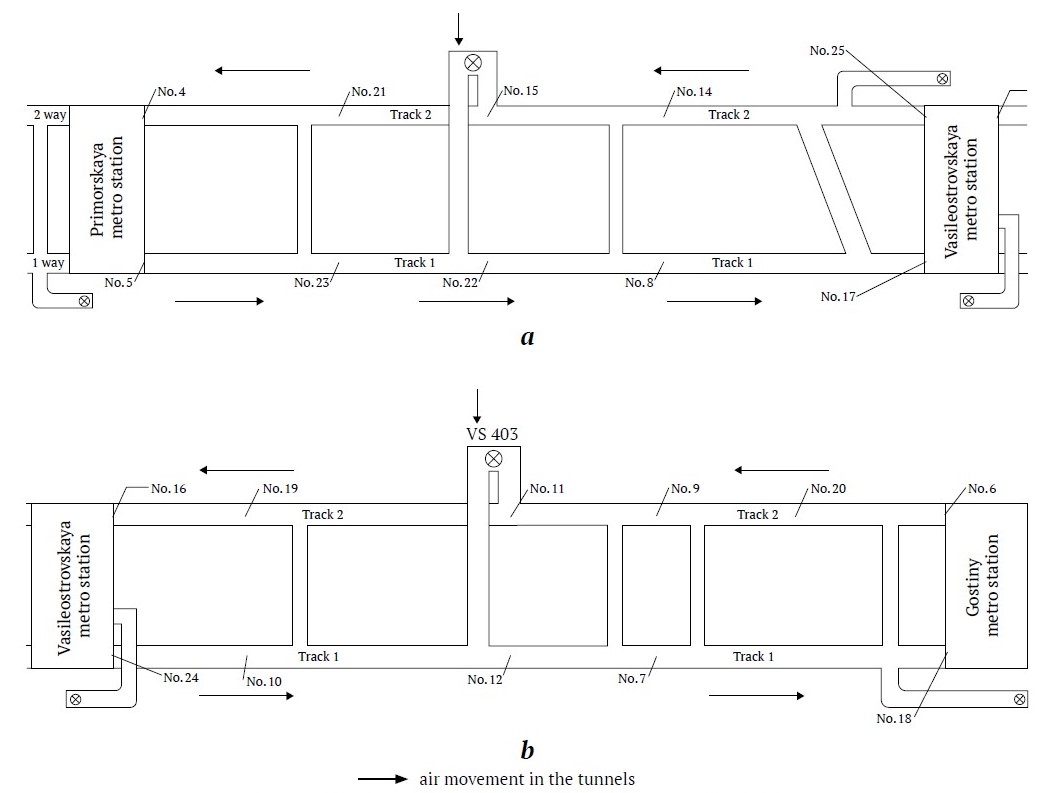
Fig. 1. Diagram of sensor placement for air temperature measurement in the single-track tunnel section of three subway lines:
а – section “Primorskaya”–”Vasileostrovskaya”; b – section “Vasileostrovskaya”–“Gostiny Dvor” [compiled by the authors]
In ventilation ducts, the temperature loggers were mounted on vertical supports, while in transport zones, they were attached to the tunnel lining. Measurements were recorded at intervals of 120 seconds over seven days, and the data were stored in the logger’s memory. Once a week, the sensors were collected, and the data were transferred to electronic media (personal computer) using a special receiver device.
Surface temperature values of the tunnel lining and relative humidity were measured during periods without train movement using an infrared pyrometer and a hygrometer (TESTO 625), respectively.
The ventilation in the "Primorskaya" – "Vasileostrovskaya" and "Vasileostrovskaya" – "Gostiny Dvor" sections during both train operation and idle periods followed specific ventilation schemes. These schemes involved supplying outside air to the stations and nearby cross-passages, with the air then being extracted through ventilation shafts along the tunnel sections. In another scenario, outside air was introduced via the station and tunnel shafts, with the outgoing airflow exhausted through the 'Gostiny Dvor' station».
In the selected segment, particularly the "Primorskaya" – "Vasileostrovskaya" section, ventilation units were operated in inflow/exhaust mode at full capacity: VOM-24R, FTDA-REV-200, with air flow rates of approximately 46–56.4 m³/s and air speeds of 4.6–5.64 m/s at a fan depression of ~922–1100 Pa.
In the "Vasileostrovskaya" – "Gostiny Dvor" track section, the following units were in use: VOM-18R, VOM-18-01, FTDA-REV-180, FTDA-REV-200. Air flow rates were ~48.6–74.8 m³/s (with speeds of 4.86–7.48 m/s) at fan depressions of ~990–1520 Pa.
The measurement results are presented in Figs. 2 and 3.
Fig. 2 shows the temperature distribution graph of air, tunnel lining surface, and humidity in the tunnels of the "Primorskaya" – "Vasileostrovskaya" – "Gostiny Dvor" sections during periods without train movement.
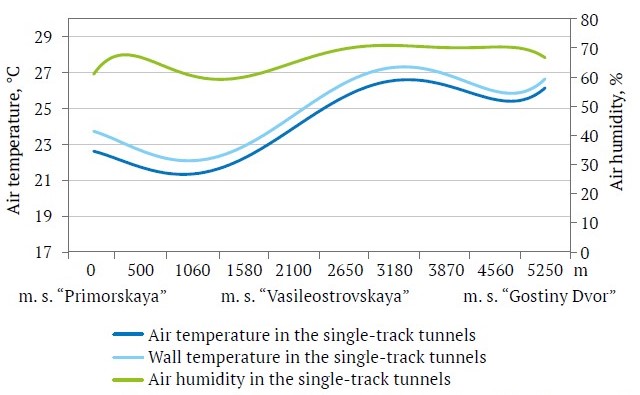
Fig. 2. Air and wall temperature distribution, and air humidity in the “Primorskaya”–“Vasileostrovskaya”–“Gostiny Dvor” section during periods without train movement [compiled by the authors]
The variation in air temperature distribution along the length of the tunnel segments is non-monotonic. The maximum temperature is observed near the station, while the minimum occurs in the middle of the section. This is due to the use of different ventilation schemes at various times of the day.
It is important to note that the air temperature is lower than the tunnel lining surface temperature, primarily because the surrounding ground heats up during the day, with train movement providing an additional heat source. The relative humidity of the air varies between 60% and 70%.
The distribution of air temperatures along the tunnel length during train movement is shown in Fig. 3.

Fig. 3. Air and wall temperature distribution, and humidity in the “Primorskaya”–“Vasileostrovskaya”–“Gostiny Dvor” section during peak hours with 24 train pairs in operation [compiled by the authors]
An analysis of the measurement results shows that the pattern of air temperature variation along the tunnel length during train movement generally follows the same distribution as when trains are not running, with some differences in temperature values between the first and second tracks.
The conducted experimental studies demonstrated that the average air temperature in the tunnels and stations can exceed the surface air temperature by ~14°C.
The reasons for this phenomenon include: significant heat emissions along the segments between stations (tunnel segments) and the use of daytime ventilation schemes that supply fresh air through ventilation shafts, leading to the formation of circulation loops.
In the tunnel section from the mixing point with outside air to the station, several factors influence the air temperature, such as increased air flow and heat emissions from moving trains, heat exchange processes between the air, tunnel structures, and the surrounding rock, as well as mass exchange processes [9].
At the same time, the increase in train movement intensity has a dual effect: on the one hand, the total amount of emitted heat increases, and on the other, the air flow in the circulation streams also increases.
Based on the developed methodology for determining air distribution parameters in subway station ventilation cross-passages, taking into account the piston effect of trains, the authors conducted a series of calculations of heat emissions and air flow in the circulation streams during train movement to quantitatively assess the interaction of these factors.
The input data for the calculations include: an average train speed of 50 km/h; the number of cars – 8; tunnel cross-section – 21 m²; and segment length – 500–3500 m. The main results of the calculations are presented in Fig. 4.
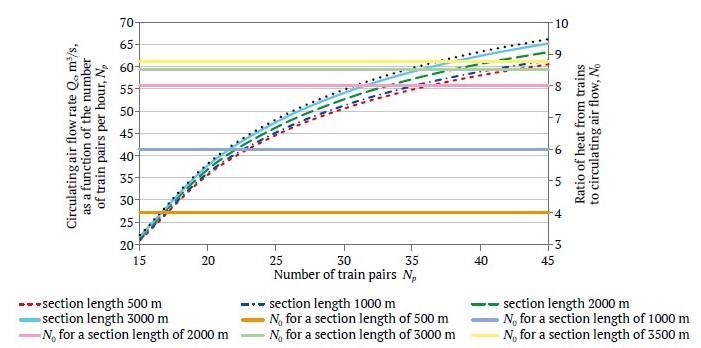
Fig. 4. Circulating air flow rate Qc and the ratio of heat from trains to circulating air flow (solid line) as a function of train traffic intensity Np (pairs/hour) [compiled by the authors]
An analysis of the obtained data shows that, with a simultaneous increase in the number of train pairs per hour from 15 to 45 and the segment length from 500 to 3500 meters, the amount of circulation air (Qc) increases by 2.5 times. Moreover, the ratio of the heat emitted by the trains to the circulation air flow (N₀) does not depend on the train intensity and varies between 4 and 8.75 for different segment lengths. At the same time, the ratio N0 remains constant for each segment length.
Thus, it can be concluded that the air temperature in the transport zones of the tunnels is practically unaffected by the frequency of train traffic.
However, an increase in the circulation air flow may lead to another negative effect—an increase in the concentration of suspended dust, especially in the spring, when atmospheric dust levels are higher. This assumption is supported by a number of studies [12].
During the operation of deep single-track tunnels, part of the heat from the rolling stock and other sources accumulates in the circulating loops. In the summer, this leads to an increase in the temperature of the tunnel air entering the stations (Fig. 2, 3). To reduce air temperature, it is possible to install refrigeration equipment in ventilation cross-passages near the stations, as described in [10].
In the winter, the circulating air, when mixed with cold outside air in the tunnel section, helps maintain a positive temperature at the stations.
Thus, the circulation loops play a dual role: in the summer, the heat accumulated in them causes additional warming of the air and progressive heating of the surrounding rock; in the winter, on the contrary, the circulating air allows for the maintenance of positive temperatures at the stations and in the tunnels [13].
Ventilation and thermal regimes of shallow single-track tunnels
A distinctive feature of the aerodynamic processes in shallow single-track tunnels, compared to those in deep tunnels, is that the circulating loops formed between stations (or cross-passages) have a close aerodynamic connection with the surface [14].
In deep subway lines, the temperature distribution along the length of the circulation loops forms in the horizontal plane and is determined only by the air flow initiated by the trains moving through parallel tunnels and the amount of heat emitted by them. In shallow tunnels, the external air entering the workings through cross-passages and pedestrian paths significantly influences the temperature distribution, as these circulating loops are fed by outside air even when the fans are not operating.
This means that the circulation loop forms in both the horizontal and vertical planes. This conclusion is confirmed by the measured air speeds at the stations "Ploshchad Gagarina-Mikhaylovskogo," "Rechnoy Vokzal," "Sibirskaya," and others in Novosibirsk.
Mixing the circulating air with external air leads to changes in the temperature distribution along the length of the circulation loop. While these changes do not lead to deviations from the standard parameters during the summer and spring periods, in the winter, the air temperature at the stations may significantly differ from the standard values, requiring the heating of outside air drawn in by the piston effect.
Based on the experimental research and numerical calculations performed, several proposals for managing the ventilation of shallow subway lines in Novosibirsk can be formulated (Fig. 5) [15].
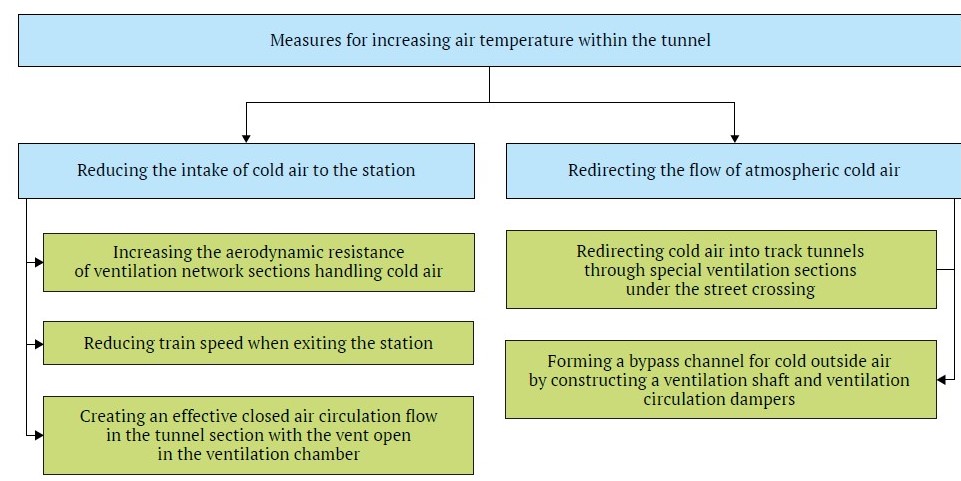
Fig. 5. Approaches to managing ventilation in shallow subway lines under the conditions of Novosibirsk [compiled by the authors]
Ventilation and thermal regimes of double-track tunnels
Field studies of the thermodynamic parameters of the air in double-track tunnels on the sections: "Dead End" – "Begovaya" – "Zenit" – the junction with the single-track tunnels leading to "Primorskaya" station (Fig. 6) were also conducted in the summer of 2023. The arrangement of sensors for measuring the thermodynamic parameters of the air is shown in Fig. 7.

Fig. 6. Profile of the double-track section:
1 – “Begovaya”; 2 – “Zenit”; 3 – junction point of single-track and double-track tunnels [compiled by the authors]
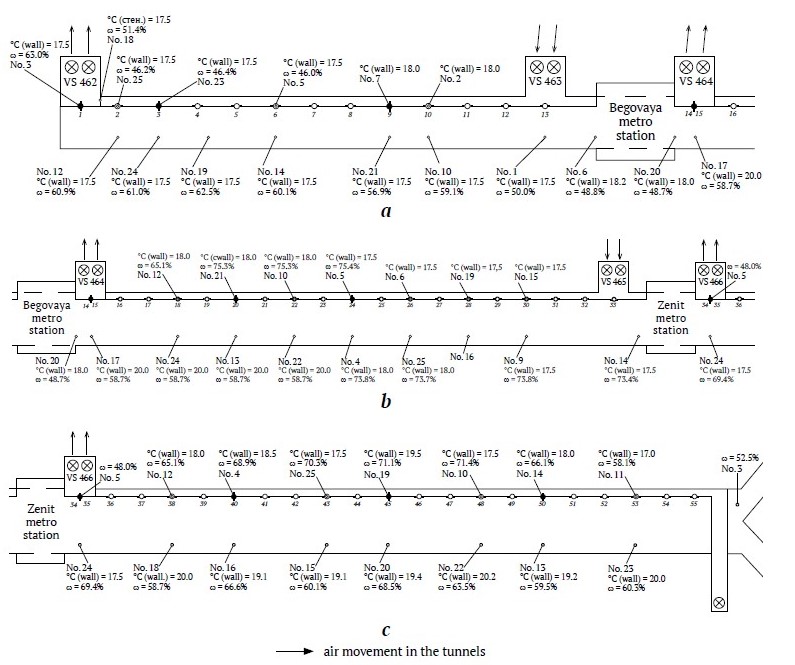
Fig. 7. Diagram of air temperature sensor placement in the double-track section of the third subway line:
a – section “Dead End”–“Begovaya”; b – section “Begovaya”–“Zenit”; c – part of the “Zenit”–“Primorskaya” section up to the junction of single-track and double-track tunnels [compiled by the authors]
The measurement methodology and equipment used were identical to those employed in the single-track tunnels.
In the selected sections ("Dead End" – "Begovaya" – "Zenit" – "Primorskaya"), fresh air was supplied through station ventilation shafts using Zitron ZVR1-18-75/6, ZVN 1-20-75/6, and FTDA-REV-200 units. Operating at 80% capacity, these units provided an airflow of ~51 m³/s and an airspeed of ~5.6 m/s at a fan depression of 925 Pa.
Air extraction from the tunnels was carried out using FTDA-REV-180 units, located in the ventilation shafts at the "Begovaya," "Zenit" stations, and in the dead-end section. These units, also operating at 80% capacity, provided an air extraction rate of ~42 m³/s (with an airspeed of ~5.6 m/s) at a fan depression of 925 Pa.
Figs. 8 and 9 show graphs illustrating the distribution of air temperature, tunnel lining surface temperature, and humidity levels in the "Begovaya" – "Zenit" section during periods of no train movement. During the measurements, the outside air temperature was 7°C, and the relative humidity was 55%.
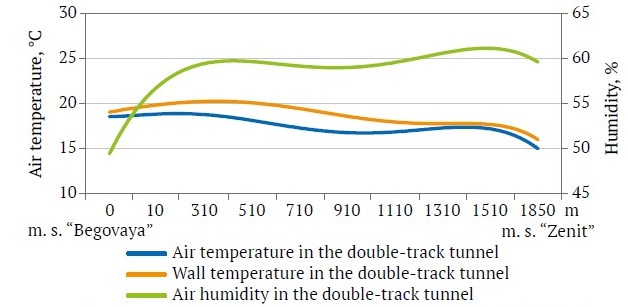
Fig. 8. Air temperature, tunnel lining surface temperature, and humidity distribution in the “Begovaya”–“Zenit” section during periods without train movement [compiled by the authors]
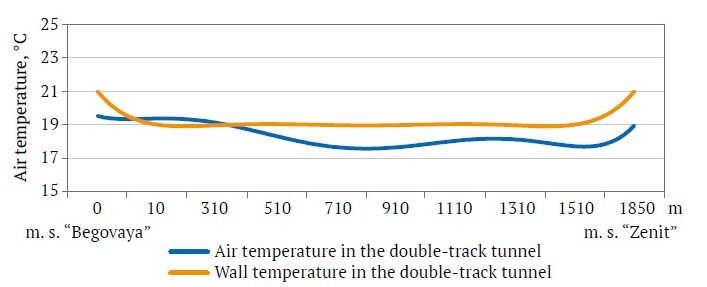
Fig. 9. Air temperature distribution in the “Begovaya”–“Zenit” section during peak hours with 24 train pairs in operation [compiled by the authors]
In the absence of train movement, the variation in the thermal regime along the section is due to the amount of heat stored in the ground during train passage. This is confirmed by the higher tunnel lining surface temperature compared to the air temperature and the distribution pattern of the air supplied by the fans along the tunnel section. Despite the heat emitted by the ground, the air temperature decreases along the section as it moves further from the "Zenit" station due to the influx of outside air, which has a significantly lower temperature than the tunnel lining surface temperature. The relative humidity along the section fluctuates within the range of 50–60%.
A different scenario occurs during train movement (Fig. 8). During the temperature measurements, the outside air temperature was recorded at 7°C.
Compared to single-track tunnels, double-track tunnels exhibit a more comfortable thermal regime. This is due to the absence of circulating airflows caused by the movement of trains. In single-track tunnels, the heat emitted by moving trains accumulates over a prolonged period since a significant portion of it is not removed along with the outgoing air from the subway [16]. In subways with double-track transit tunnels, due to the lack of circulating airflows (piston effect), most of the heat is evenly distributed along the tunnel section [17]. The consistency of air temperature is maintained through heat removal, except in zones near the stations. In these zones, the intensity of heat generation is highest during train braking and stops. As a result, the air temperature exceeds the tunnel lining surface temperature, indicating the transfer of heat to the ground.
For sections with double-track tunnels, an increase in temperature is observed with higher train traffic intensity, which is directly related to the increase in heat emissions from the trains.
Ventilation and thermal regimes in sections with single-track and double-track tunnels
A key distinction in the ventilation and thermal regimes of the sections under consideration is the difference in airflow dynamics between the double-track and single-track tunnels. Single-track tunnel sections are ventilated through a combination of forced ventilation and the piston effect. Additionally, a circulation loop forms between the junction of the double-track and single-track tunnels and the stations closest to the junction [18].
In contrast, the ventilation of double-track tunnels is managed solely by shaft fans.
When trains are not operating, the temperature and humidity distribution along the section from 'Zenit' station to 'Primorskaya' station remains consistent for both double-track and single-track tunnels (Fig. 10). During the measurements, the outside air temperature was 13°C, and the humidity level was 69%."
During train movement, when the air temperature beyond the junction with the double-track tunnels aligns with the typical temperature distribution found in single-track tunnels, it is possible for the temperature to exceed the absolute values observed in the single-track tunnels (Fig. 11). During the measurements, the outside air temperature was recorded at 17°C.

Fig. 10. Air temperature distribution in the “Zenit”–“Primorskaya” section during periods without train movement, with the junction point where the double-track tunnel transitions into two single-track tunnels [compiled by the authors]

Fig. 11. Air temperature distribution in the “Zenit”–“Primorskaya” section during peak-hour train operation (24 pairs/hour) [compiled by the authors]
The above is confirmed by measurement results, which show that the air temperature in the double-track tunnel before the junction, at a point 2010 meters from 'Zenit' station, was 19.5°C, while at 'Primorskaya' station, it increased to 22–23°C. This increase is due to the circulation loop in the single-track section being fed with air from the double-track tunnel, which has a higher temperature than the outside air supplied from the surface, as is typical in standard ventilation schemes.
To lower the temperature regime in single-track tunnels, a ventilation method using outside air can be applied. This method involves supplying fresh air into the double-track tunnel through a specially designed shaft located at the end of the double-track section.
Conclusions
Based on the experimental research conducted, the patterns of ventilation and thermal regimes in single-track, double-track tunnels, and junction sections were identified, and measures were proposed to improve these regimes to ensure compliance with climate standards. Specifically, the following findings were made:
- In deep single-track tunnels, the thermal regime is influenced by two main factors: air circulation between stations, caused by the piston effect, and heat emissions from moving trains. The temperature distribution along the tunnels is uneven, with minimum values in the middle and maximum values at the stations. This phenomenon is a result of the ventilation system, which introduces fresh air into the tunnels and expels it at the stations. As train traffic intensity increases, there is no significant change in air temperature, which can be attributed to the rise in circulating air flow.
- In shallow single-track tunnels, the circulation loop formed between stations is fed by outside air entering through pedestrian paths at the stations and tunnels. During the summer, this phenomenon does not significantly affect the temperature distribution. However, in winter, it can lead to a critical drop in temperature at the stations. Maintaining standard air parameters at the stations during the winter can be achieved through a combination of organizational, aerodynamic, and thermal engineering methods. The first method involves reducing the piston effect by slowing down the arrival and departure of trains. The second approach increases the aerodynamic resistance in sections of the ventilation system, facilitating the movement of cold atmospheric air or internal circulation loops. The third method involves using systems to heat the incoming outside air, such as air-thermal curtains.
- In double-track tunnels, when trains are not in operation, the temperature variation along the tunnel is determined by the amount of heat retained in the ground during train movement. When trains are running, the heat emitted by trains moving in opposite directions, with minimal piston effect, is evenly distributed along the tunnel. This results in a consistent air temperature throughout the tunnels, except near stations, where braking and stopping generate maximum heat. Consequently, the air temperature in these areas increases by 2–3°C compared to the rest of the tunnel.
In sections with both double-track and single-track tunnels, the rise in air temperature at stations near single-track tunnels is due to the formation of circulation flows between the junction of the double-track and single-track tunnels and the adjacent station.
- Recommendations for normalizing the aerothermodynamic regime for the tunnel types studied include the following:
- In cases where air temperature may exceed standard values in the summer, provisions should be made for either an air flow reserve or air cooling in cross-passages near the stations.
- To increase air temperature, organizational, aerodynamic, and heat engineering methods can be applied: the first involves reducing the piston effect by lowering train speeds; the second involves increasing the aerodynamic resistance in ventilation network sections connected to the intake of outside air; and the third entails using systems to heat cold external air, such as air-thermal curtains.
- In sections that combine double-track and single-track tunnels, the potential rise in air temperature at stations near single-track tunnels can be mitigated by supplying outside air into the double-track tunnel through a shaft located at the end of the double-track section.
References
1. Yungmeister D. A., Yacheykin A. I. Rational design justification of the tunnel boring shield executive body for the conditions of the mines of Saint Petersburg Metrostroy. Journal of Mining Institute. 2021;249:441–448. https://doi.org/10.31897/PMI.2021.3.13
2. Dashko R. E., Lokhmatikov G. A. The Upper Kotlin clays of the Saint Petersburg region as a foundation and medium for unique facilities: an engineering-geological and geotechnical analysis. Journal of Mining Institute. 2022;254:180–190. https://doi.org/10.31897/PMI.2022.13
3. Maevski I. Features of tunnel ventilation systems design in hot climate. In: Proceedings from 12 th International Symposium on Aerodynamics and Ventilation of Vehicle Tunnels. Portoroz, Slovenia, 11–13 July 2006. BHR Group; 2006. Pp. 331–347.
4. Kiyanitsa L. A. Determining analytical dependences for heat flow in soil from enclosed-type shallow underground subway stations with double-track tunnels. Mining Informational and Analytical Bulletin. 2018;(2):89–102. (In Russ.)
5. Zedgenizov D. V. To calculation of the coefficients of automatic regulator of tunnel fan capacity. InterekspoGeo-Sibir’. 2021;2(3):213–218. (In Russ.) https://doi.org/10.33764/2618-981X-2021-2-3-213-218
6. Tsodikov V. Ya. Chapter III. Ventilation systems of subway tunnels and the main provisions of their calculations. In: Ventilation and Heat Supply of Subways. 2nd ed. Moscow: Nedra Publ.; 1975. (In Russ.)
7. Vardy A., Hagenah B. Full-scale flow measurements in a tunnel air shaft. In: Proceedings from 12 th International Symposium on Aerodynamics and Ventilation of Vehicle Tunnels. Portoroz, Slovenia, 11–13 July 2006. BHR Group; 2006. Pp. 343–357.
8. Sahlin P., Eriksson L., Grozman P. et al. 1D models for thermal and air quality prediction in underground traffic systems. In: Proceedings from 12 th International Symposium on Aerodynamics and Ventilation of Vehicle Tunnels. Portoroz, Slovenia, 11–13 July 2006. Pp. 261–267.
9. Kiyanitsa L. A., Unaspekov B. A. Estimate of air distribution in ventilation tunnel between subway station as function of piston effect. Mining Informational and Analytical Bulletin.2021;(12):99–109. (In Russ.) https://doi.org/10.25018/0236_1493_2021_12_0_99
10. Gendler S. G., Kryukova M. S. Thermal management of metro lines with single-track tunnels. Izvestija Tulskogo Gosudarstvennogo Universiteta. Nauki o Zemle. 2022;(4):116–127. (In Russ.)
11. Gendler S. G., Kryukova M. S. Problems of operation of metro lines with double-track tunnels in a cold climate. Izvestija Tulskogo Gosudarstvennogo Universiteta. Nauki o Zemle. 2022;(2):77–87. (In Russ.)
12. Smirnyakov V. V., Rodionov V. A., Smirnyakova V. V., Orlov F. A. The influence of the shape and size of dust fractions on their distribution and accumulation in mine workings when changing the structure of air flow. Journal of Mining Institute. 2022;253:71–81. https://doi.org/10.31897/PMI.2022.12
13. Lugin I. V., Pavlov S. A., Irgibaev T. I. Justification of the parameters of ring models in the decomposition of the ventilation network of an extended metro line for the calculation of air distribution. Interekspo Geo-Sibir’. 2022;2(3):214–220. https://doi.org/10.33764/2618-981X-2022-2-3-214-220
14. Kiyanitsa L. A., Lugin I. V., Krasyuk A. M. On air flow structure in station ventilation connections of subways. Interekspo Geo-Sibir’. 2021;2(3):219–229. (In Russ.) https://doi.org/10.33764/2618-981X-2021-2-3-219-229
15. Krasyuk A. M., Lugin I. V. Keepeing of microclimate parameters at terminal station of subway line. InterekspoGeo-Sibir’. 2019;2(4):122–130. (In Russ.) https://doi.org/10.33764/2618-981X-2019-2-4-122-130
16. Zhikharev S. Enhanced methodology for thermal management area assessment of metro lines. In: E3S Web of Conferences. IV International Conference on Geotechnology, Mining and Rational Use of Natural Resources (GEOTECH-2024). 2024;525:05018. https://doi.org/10.1051/e3sconf/202452505018
17. Zhikharev S. Methodological approach to determining the area of air recycling on metro lines with double track tunnels. In: E3S Web of Conferences. XIV International Conference on Transport Infrastructure: Territory Development and Sustainability (TITDS-XIV-2023). 2024;471:02022. https://doi.org/10.1051/e3sconf/202447102022
18. Karimov D. Numerical simulation of aerodynamic processes of air mass movement in underground tunnels taking into account piston impact of rolling stock. Proceedings of Petersburg Transport University. 2022;19(1):17–27. (In Russ.) https://doi.org/10.20295/1815-588X-2022-19-1-17-27
About the Authors
S. G. GendlerRussian Federation
Simeon G. Gendler – Dr. Sci. (Eng.), Professor, Head of the Department of Industrial Safety
Scopus ID 56168675100, ResearcherID I-9283-2017
St. Petersburg
M. S. Kryukova
Russian Federation
Milana S. Kryukova – PhD-Student of the Department of Industrial Safety
Scopus ID 58723622900
St. Petersburg
E. L. Alferova
Russian Federation
Elena L. Alferova – Engineer, Researcher
Scopus ID 57193708767
Novosibirsk
Review
For citations:
Gendler S.G., Kryukova M.S., Alferova E.L. Investigation of thermodynamic parameters of the air environment in subway lines with single-track and double-track tunnels. Mining Science and Technology (Russia). 2024;9(3):250-262. https://doi.org/10.17073/2500-0632-2024-02-223




































